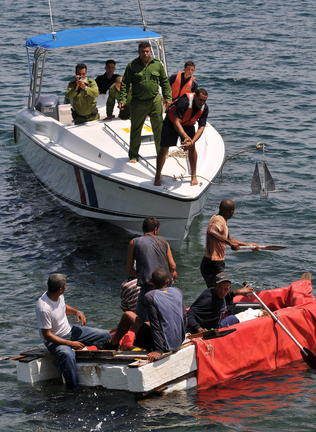 Those who know him in the Pedro Luis Garcia neighborhood call him “the little rafter,” for the number of times he’s tried to flee the country by way of the sea. Until today, he hasn’t managed to reach his goal, but he swears he won’t stop trying and the only way they can stop him is to put him in prison.
Those who know him in the Pedro Luis Garcia neighborhood call him “the little rafter,” for the number of times he’s tried to flee the country by way of the sea. Until today, he hasn’t managed to reach his goal, but he swears he won’t stop trying and the only way they can stop him is to put him in prison.
He can even recite Article 13 from the Declaration of Human Rights from memory and in a rap rhythm: “Everyone has the right to freedom of movement and residence within the borders of each state. Everyone has the right to leave any country, including his own, and to return to his country.” Some have declared him nuts.
In Cuba, leaving or entering the country is subject to legal procedures, which, if not met, constitute a crime with a fine of 300 to 500 pesos, or up to three years imprisonment, rising to up to eight years if violence or intimidation of people is used, or force in the attempt.
No one could believe that “the little rafter,” barely five and a half feet tall and less than 100 pounds, has launched 14 attempts to leave the country illegally. Nine of his attempts happened between 1998 and 2004, and were frustrated by U.S. authorities.
He was returned in compliance with the migration accords between both nations in 1994, after the second Mariel exodus. At that time the young man, now 28, was barely an adolescent of 12.
Despite being a criminal, Pedro Luis was never sanctioned for this reason. The Cuban state, adhering to the bilateral treaty, agreed to suspend the application of judicial sanctions against rafters repatriated to the island.
In 4 of his recent tries, he had to return voluntarily, due to technical problems with his rustic boat, which couldn’t even be called a “raft.” On the most recent, less than 8 months ago, he was caught red-handed by the Cuban Coast Guard, nine miles off the coast of the island.
Although the same thing had happened on earlier tries, when they returned him to his house this time it was different. Just a month later he was notified of a resolution by the Havana Harbor Master that he was imposing on him and on each one of traveling partners, an eight thousand peso fine for violating the regulations governing possession and sailing of boats.
He had incurred four of the 14 infractions detailed in Decree Law 194, “Of the infractions regarding the possession and operation of boats in the national territory,” classified as very serious.
They fined him for building a boat without authorization, using it in illicit ways, operating it without its being registered with the Harbor Master, and navigating in territorial waters without permission.
The provision issued by the State Council authorizes the Harbor Master to apply forfeiture and civil penalties, in an amount ranging from 500 to 10,000 pesos, depending on the rating of the violations received: minor, serious and very serious. It also punishes recidivism or the commission of several offenses.
Pedro wasn’t expecting it, in fact he didn’t even know such rules existed. Nor does he understand why the Harbor Master didn’t make any reference to leaving the country illegally. “Well, if it’s not for one thing it’s for another, they always keep an ace up their sleeve,” he commented.
In any event, he has no income nor assets with which to pay the fine. The little rafter is convinced he should try to flee the country. “It’s better to die trying to do what you want, and even much better than ending up in prison for not paying a fine. Until the thousandth and one try,” he concludes.
January 24 2011
